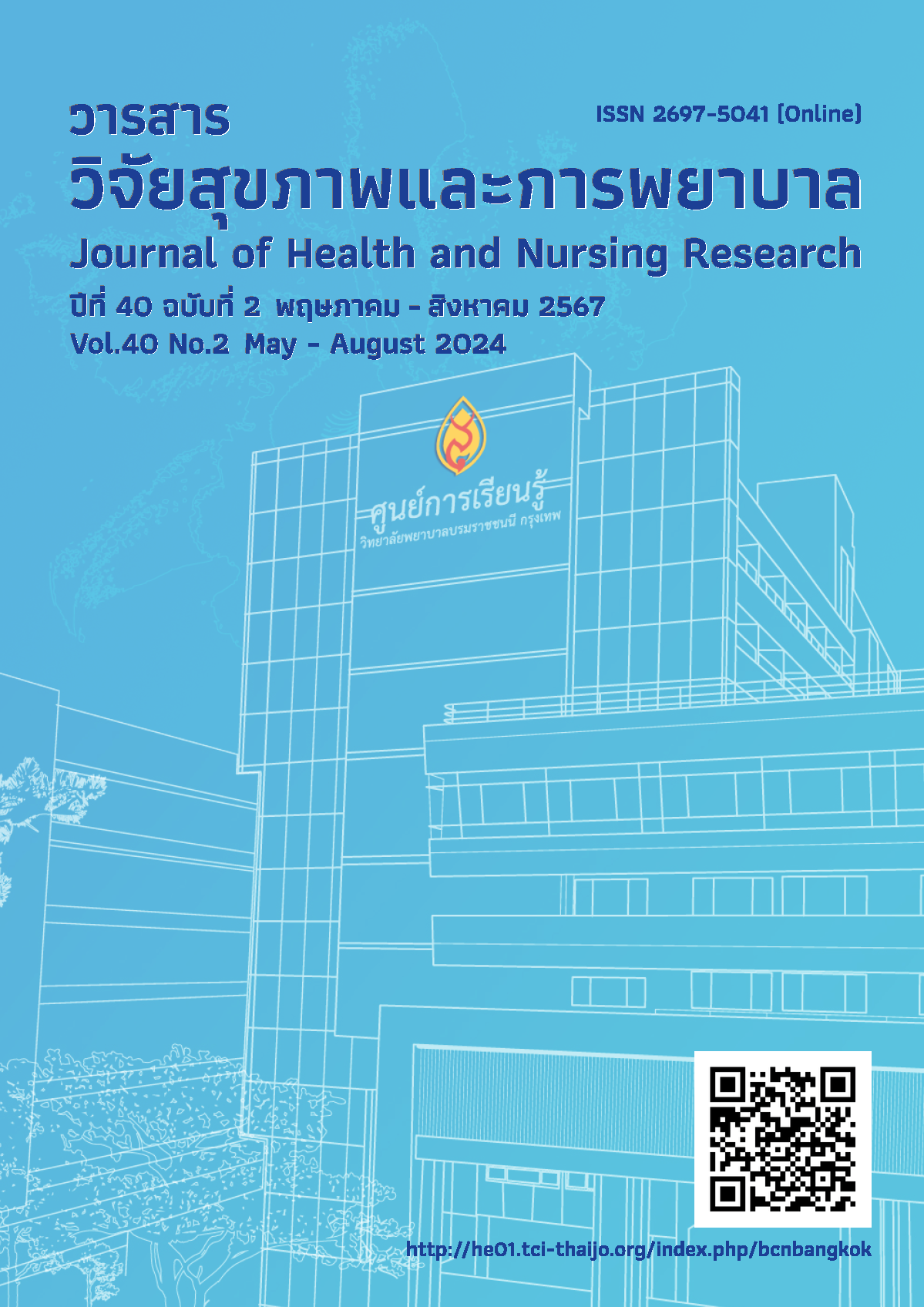การจมน้ำของเด็กอายุต่ำกว่า 5 ปี: สภาพปัญหา ปัจจัยเชิงสาเหตุ และแนวทางการแก้ไข
คำสำคัญ:
การจมน้ำในเด็ก , แบบแผนความเชื่อทางด้านสุขภาพ , พฤติกรรมของผู้ดูแลเด็ก, ปัจจัยเชิงสาเหตุบทคัดย่อ
บทนำ: การจมน้ำของเด็กอายุต่ำกว่า 5 ปี ในสังคมไทยเกิดขึ้นอย่างต่อเนื่อง โดยผลกระทบที่เกิดขึ้นนอกจากจะส่งผลถึงความบาดเจ็บทางด้านร่างกาย จิตใจ และอาจจะถึงแก่ชีวิตของเด็กแล้ว ยังมีผลต่อคุณภาพชีวิตของครอบครัว การเข้าใจถึงสภาพปัญหา ปัจจัยเชิงสาเหตุ และแนวทางการแก้ไขปัญหา สามารถทำให้บุคลากรที่เกี่ยวข้องดำเนินการป้องกันปัญหาได้อย่างมีประสิทธิภาพ
วัตถุประสงค์: เพื่อนำเสนอสภาพปัญหา ปัจจัยเชิงสาเหตุ และแนวทางการแก้ไขปัญหาการจมน้ำของเด็กอายุต่ำกว่า 5 ปี โดยสังเคราะห์จากงานวิจัยที่ตีพิมพ์เผยแพร่
ประเด็นสำคัญ: ปัญหาการจมน้ำของเด็กอายุต่ำกว่า 5 ปี ในสังคมไทยส่วนใหญ่เกิดขึ้นในแหล่งน้ำภายในหรือบริเวณรอบ ๆ ที่พักอาศัย โดยปัจจัยเชิงสาเหตุที่สำคัญ คือ พฤติกรรมการป้องกันการจมน้ำในเด็กของผู้ดูแลเด็กในเรื่องการดูแลเด็กอย่างใกล้ชิด และการจัดการสิ่งแวดล้อมบริเวณที่พักอาศัย โดยปัจจัยเชิงสาเหตุของการมีพฤติกรรมมาจากปัจจัยเชิงสาเหตุภายในตัวบุคคลของผู้ดูแลเด็ก ซึ่งสอดคล้องกับแบบแผนความเชื่อทางด้านสุขภาพ และการแก้ไขปัญหาควรดำเนินการให้ผู้ดูแลเด็ก มีพฤติกรรมการป้องกันการจมน้ำในเด็กที่พึงประสงค์ ด้วยการใช้กลวิธีที่หลากหลาย และบูรณาการเข้ากับกิจกรรมของหน่วยบริการสาธารณสุขในพื้นที่
สรุป: การแก้ไขปัญหาการจมน้ำในเด็กโดยการเสริมสร้างพฤติกรรมการป้องกันการจมน้ำในเด็กของผู้ดูแลเด็กเป็นส่วนสำคัญที่ควรดำเนินการ ซึ่งบุคลากรสาธารณสุขในสถานบริการสาธารณสุขในระดับปฐมภูมิเป็นบุคลากรที่สำคัญที่จะสามารถแก้ไข ป้องกันปัญหาได้อย่างมีประสิทธิภาพ
ข้อเสนอแนะ: แนวทางที่นำเสนอสามารถนำไปพัฒนาแนวทางในการดำเนินการหรือการศึกษาวิจัยด้วยการดำเนินการโดยเฉพาะในพื้นที่ที่มีอุบัติการณ์สูง
Downloads
เอกสารอ้างอิง
Division of Injury Prevention, Department of Disease Control. Drowning prevention course for program manager. Bangkok: Rumthai press; 2020. (in Thai)
World Health Organization. Drowning [Internet]. 2023 [cited 2023 Dec 15]. Available from: https://www.who.int/news-room/fact-sheets/detail/drowning
World Health Organization. Regional status report on drowning in South-East Asia. New Delhi: World Health Organization; 2021.
Strategy and Planning Division, Office of the Permanent Secretary, Ministry of Public Health. Public health statistics A.D. 2022. Nonthaburi: Strategy and Planning Division, Office of the Permanent Secretary Ministry of Public Health; 2023. (in Thai)
Division of Injury Prevention, Department of Disease Control. Drowning report system [Internet]. 2023 [cited 2023 Oct 10]. Available from: https://dip.ddc.moph.go.th/satdrowning
Wang M, Liu Y, Kang L, He C, Miao L, Huang J, et al. Social and environmental risk factors for the accidental drowning of children under five in China. BioMed Central Public Health 2020;20(1):1553. doi: 10.1186/s12889-020-09650-0.
Chivanon N. Accidents in children: situation and prevention. The Journal of Faculty of Nursing Burapha University 2016;24(3):1-12. (in Thai)
Cronan KM. Protecting kids from water & drowning hazards [Internet]. 2021 [cited 2023 Oct 20]. Available from: https://kidshealth.org/en/parents/safety-drowning.html
World Health Organization. Hidden depths: the global investment case for drowning prevention. Geneva: World Health Organization; 2023.
Plitapolkarnpim A. Guidelines for child safety promotion and injury prevention. In: Noipayak P, Piyasil W, Ningsanon W, Ungthavorn P, editors. Guideline in child health supervision. Bangkok: Sappasarn; 2014. p. 101-26. (in Thai)
Gerdmongkolgan S, Ekchaloemkiet S, Dumnakkaew K. Descriptive analysis of the drowning injury surveillance system in all 5 dimensions of operations. In: Hinjoy S, Thiparat K, Tachakamonsuk P, editors. Summary of guidelines for analysis of surveillance systems for 5 disease groups, 5 dimensions, year 2016. Samutprakan: TS Interprint; 2016. p. 122-9. (in Thai)
Denny SA, Quan L, Gilchrist J, McCallin T, Shenoi R, Yusuf S, et al. Prevention of drowning. Pediatrics 2021;148(2):e2021052227. doi: 10.1542/peds.2021-052227.
Liu Z, Kong F, Yin L, Wang A, Xiong L, Xie D, et al. Epidemiological characteristics and influencing factors of fatal drowning in children under 5years old in Hunan Province, China: case-control study. BioMed Central Public Health. 2019;19(1):955. doi: 10.1186/s12889-019-7241-z.
Gerdmongkolgan S, Ekchaloemkiet S, Jongsukklai K. An in-depth study of drowning among children under 5 years of age in Thailand. Journal of the Office of DPC 7 Khon Kaen 2023;30(3):49-61. (in Thai)
World Health Organization. WHO Guideline on the prevention of drowning through provision of day-care and basic swimming and water safety skills. Geneva: World Health Organization; 2021.
World Health Organization. Preventing drowning: an implementation guide. Geneva: World Health Organization; 2017.
Hossain M, Mani KKC, Sidik SM, Hayati KS, Rahman AKMF. Socio-demographic, environmental and caring risk factors for childhood drowning deaths in Bangladesh. BioMed Central Pediatrics 2015;15(1):114. doi: 10.1186/s12887-015-0431-7.
International Life Saving Federation.Drowning prevention strategies: a framework to reduce drowning deaths in the aquatic environment for nations/regions engaged in lifesaving. Belgium: The International Life Saving Federation; 2015.
Estebsari F, Filabadi ZR, Matbouei M, Nasiri M. Application of a risk management program based on the health belief model for preventing home accidents. Iranian Journal of Nursing and Midwifery Research 2023;28(1):78-84. doi: 10.4103/ijnmr.ijnmr_367_21.
Moridi E, Fazelniya Z, Yari A, Gholami T, Hasirini PA, Khani Jeihooni A. Effect of educational intervention based on health belief model on accident prevention behaviours in mothers of children under 5-years. BioMed Central Women's Health 2021;21(1):428. doi: 10.1186/s12905-021-01573-1.
Green EC, Murphy EM, Gryboski K. The health belief model. In: Sweeny K, Robbins ML, Cohen LM, editors. The wiley encyclopedia of health psychology: volume II, The Social Bases of Health Behavior. New York: Wiley-Blackwell; 2020. p. 211-4. doi: 10.1002/9781119057840.ch68
Faengphong N, Junprasert S, Rattanagreethakul S. Effects of health belief development program among parents on perceptions and hand-foot-mouth disease preventive behaviors for preschool-aged children in child development center. The Journal of Faculty of Nursing Burapha University 2020;28(3):113-25. (in Thai)
Sandomierski MC, Morrongiello BA, Colwell SR. S.A.F.E.R. Near water: an intervention targeting parent beliefs about children's water safety. Journal of Pediatric Psychology 2019;44(9):1034-45. doi: 10.1093/jpepsy/jsz042.
Abbassinia M, Barati M, Afshari M. Effectiveness of interventions in the prevention of home injuries among children under 5 years of age: a systematic review. Archives of Trauma Research 2019;8(4):190-7.
Stehr P, Reifegerste D, Rossmann C, Caspar K, Schulze A, Lindemann AK. Effective communication with caregivers to prevent unintentional injuries in children under seven years. A systematic review. Patient Education and Counseling 2022;105(8):2721-30. doi: 10.1016/j.pec.2022.04.015.
ดาวน์โหลด
เผยแพร่แล้ว
รูปแบบการอ้างอิง
ฉบับ
ประเภทบทความ
สัญญาอนุญาต
ลิขสิทธิ์ (c) 2024 วารสารวิจัยสุขภาพและการพยาบาล (วารสารวิทยาลัยพยาบาลบรมราชชนนี กรุงเทพ)

อนุญาตภายใต้เงื่อนไข Creative Commons Attribution-NonCommercial 4.0 International License.
บทความที่ได้รับการตีพิมพ์ เป็นลิขสิทธิ์ของวารสารวิจัยสุขภาพและการพยาบาล (วิทยาลัยพยาบาลบรมราชชนนี กรุงเทพ) ไม่สามารถนำไปตีพิมพ์ซ้ำในวารสารฉบับอื่น


















